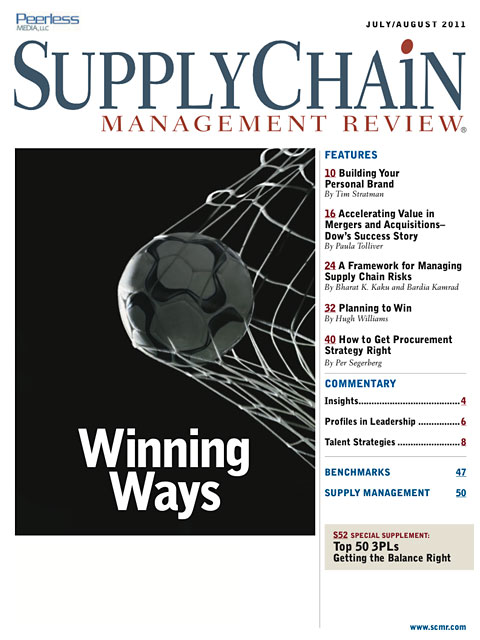Sorry, but your login has failed. Please recheck your login information and resubmit. If your subscription has expired, renew here.
July-August 2011
Winning and winners have a powerful fascination for us. Everyone seems to go crazy when their favorite team wins a championship (think Boston Bruins in the recent Stanley Cup). Individuals bring out the adulation in us, too, whether they are in sports, politics, the community, or religious leaders. And don't forget business. Jack Welch, Bill Gates, and yes, Donald Trump are among the business "winners" who have captivated us. By developing winning ways, supply chain people can put themselves in great position for a long and fulfilling career. We hope that the articles in our July/August issue will accelerate your progress along that… Browse this issue archive.Need Help? Contact customer service 847-559-7581 More options
Two facts are widely recognized in industry and academia. First, successful supply chain management is a key to competitive advantage. Second, global supply chains are increasingly vulnerable to risks that can have a significant negative impact on a company’s profitability—and even survival. This makes risk management a critical task for any company. Yet what’s missing is a set of guidelines that managers can use to accomplish this task. This article fills that void by offering a framework they can use to address the following essential components in risk management: identifying risks, evaluating the negative consequences of risk factors, preparing for adverse events arising from these risks, reacting to events, and recovering from an event’s negative effects.
Part of this framework is an iterative process with feedback loops for learning and improvement. Another distinguishing feature is a classification scheme that allows managers to identify risks along the dimensions of probability of occurrence, the potential magnitude and cost of an adverse event, and the degree of control a manager can exercise over the factors causing the risk—all of which provide useful inputs into the decision-making process for risk management.
 |
This complete article is available to subscribers
only. Click on Log In Now at the top of this article for full access. Or, Start your PLUS+ subscription for instant access. |
Not ready to subscribe, but need this article?
Buy the complete article now. Only $20.00. Instant PDF Download.
Access the complete issue of Supply Chain Management Review magazine featuring
this article including every word, chart and table exactly as it appeared in the magazine.
SC
MR
Sorry, but your login has failed. Please recheck your login information and resubmit. If your subscription has expired, renew here.
July-August 2011
Winning and winners have a powerful fascination for us. Everyone seems to go crazy when their favorite team wins a championship (think Boston Bruins in the recent Stanley Cup). Individuals bring out the adulation in… Browse this issue archive. Download a PDF file of the July-August 2011 issue.
 |
Download Article PDF |
Two facts are widely recognized in industry and academia. First, successful supply chain management is a key to competitive advantage. Second, global supply chains are increasingly vulnerable to risks that can have a significant negative impact on a company’s profitability—and even survival. This makes risk management a critical task for any company. Yet what’s missing is a set of guidelines that managers can use to accomplish this task. This article fills that void by offering a framework they can use to address the following essential components in risk management: identifying risks, evaluating the negative consequences of risk factors, preparing for adverse events arising from these risks, reacting to events, and recovering from an event’s negative effects.
Part of this framework is an iterative process with feedback loops for learning and improvement. Another distinguishing feature is a classification scheme that allows managers to identify risks along the dimensions of probability of occurrence, the potential magnitude and cost of an adverse event, and the degree of control a manager can exercise over the factors causing the risk—all of which provide useful inputs into the decision-making process for risk management.
 |
SUBSCRIBERS: Click here to download PDF of the full article. |
SC
MR

Latest Supply Chain News
- Inflation, economic worries among top supply chain concerns for SMBs
- April Services PMI declines following 15 months of growth, reports ISM
- Attacking stubborn COGS inflation with Digital Design-and-Source-to-Value
- Despite American political environment, global geopolitical risks may be easing
- Joseph Esteves named CEO of SGS Maine Pointe
- More News
Latest Podcast

 Explore
Explore
Latest Supply Chain News
- Inflation, economic worries among top supply chain concerns for SMBs
- April Services PMI declines following 15 months of growth, reports ISM
- Attacking stubborn COGS inflation with Digital Design-and-Source-to-Value
- Despite American political environment, global geopolitical risks may be easing
- Joseph Esteves named CEO of SGS Maine Pointe
- Employees, employers hold divergent views on upskilling the workforce
- More latest news
Latest Resources

Subscribe

Supply Chain Management Review delivers the best industry content.

Editors’ Picks





